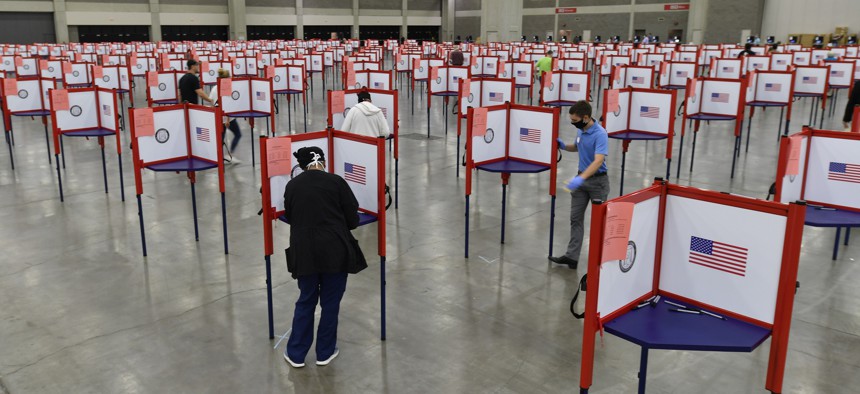Experts Say Investment Needed in Both Absentee, In-Person Voting Before November

Voting stations are set up in the South Wing of the Kentucky Exposition Center for voters to cast their ballot in the Kentucky primary in Louisville, Ky., Tuesday, June 23, 2020. AP Photo/Timothy D. Easley
Difficulties that emerged during Kentucky and New York’s primary elections Tuesday underscore the need for more resources to accommodate voters who cast ballots by mail and in person.
Kentucky’s primary elections saw long lines Tuesday at some mega polling places. In New York, some voters complained they had to head to the polls in person after their absentee ballots didn’t arrive on time.
But the problems weren’t as widespread as those that created chaotic scenes earlier this spring during other states’ primaries held after the start of the coronavirus pandemic. Experts said they still illustrate the lessons to be learned about the underlying difficulty states face as they seek to quickly expand vote-by-mail capabilities in response to the coronavirus outbreak and issues states will need to address ahead of the November presidential election.
“Many of the problems we have been seeing with wait times were things that were predictable and could have been minimized with better protocol and planning,” said Myrna Pérez, director of the Brennan Center’s Voting Rights and Elections Program. “What they should be evaluating is what was the cause of the long lines and how can it be reduced.”
Citing concerns about the potential spread of the coronavirus, Kentucky’s governor and secretary of state reached an agreement that allowed all eligible voters access to absentee ballots. But county clerks limited the number of polling places that would be open on Election Day, reducing the number from several thousand to just 170 sites. Polls were consolidated into one mega voting center in two of the state’s most populous cities—Louisville, which has a population of more than 600,000, and Lexington, home to more than 300,000 people.
In Fayette County, which includes Lexington, wait times grew to more than an hour early in the day outside Kroger Field, the college football stadium used as a voting center. The logjam was the limited number of voter check-in stations. In response, Fayette County Clerk Don Blevins Jr. added two more check-in stations by midday to help speed up the process.
Altogether, about 889,000 voters in the state requested absentee ballots, while another 110,000 voted in person early, and 169,000 cast ballots on Election Day.
Kentucky Secretary of State Michael Adams fended off accusations, including from former Secretary of State Hillary Clinton, that the state’s elections protocol amounted to voter suppression.
He said celebrities from outside the state “have aggressively pushed a false, culturally bigoted narrative that paints Kentucky as a racist backwater that suppresses the votes of African-Americans.”
“Make no mistake: this sort of misinformation is a direct threat to Kentucky’s elections,” Adams said.
Large-scale voting centers can help consolidate election resources, but Pérez warned that they must be adequately staffed, have enough voting machines, and paperwork to work. Elections officials should also have back up plans in place in case machines malfunction or poll workers run into other difficulties. In Georgia, malfunctioning voting machines led to hours-long waits in some counties earlier this month.
In New York, another problem plaguing elections officials was the process of getting absentee ballots to voters.
Approximately 765,000 absentee ballots were sent out in New York City, but the New York Times reported that many voters in line at polling places Tuesday said they never received the requested ballots.
The problems associated with absentee voting there “were really an issue of capacity,” said Joe Burns, a former deputy director at the New York State Board of Elections.
New York Gov. Andrew Cuomo signed an executive order at the end of April to send absentee ballot applications to all registered voters in the state. That didn’t leave a lot of time to send out applications and process requests to get the ballots out to voters, Burns said.
“That was an awful lot to ask of the county boards,” he said in a call Wednesday organized by the Lawyers Democracy Fund, a conservative group that works on elections issues.
Leaders of VoteSafe, a bi-partisan coalition of election administrators and organizations, said Tuesday’s primaries highlight the need for states must do more to both prepare for increased absentee voting and high in-person turnout.
“States, like New York, must dramatically adjust their capacity to process absentee applications, mail out ballots, and count returned ballots to avoid confusion,” said VoteSafe co-chairs, former Secretary of Homeland Security and Pennsylvania Governor Tom Ridge and former Michigan Governor Jennifer Granholm, in a statement. “It cannot still be the case in November that voters apply for absentee ballots that never come.”
Further, they said states must ensure that in-person voting can be done safely and efficiently.
Andrea Noble is a staff correspondent with Route Fifty.
NEXT STORY: State Fairs Are the Latest Casualty of Covid-19





